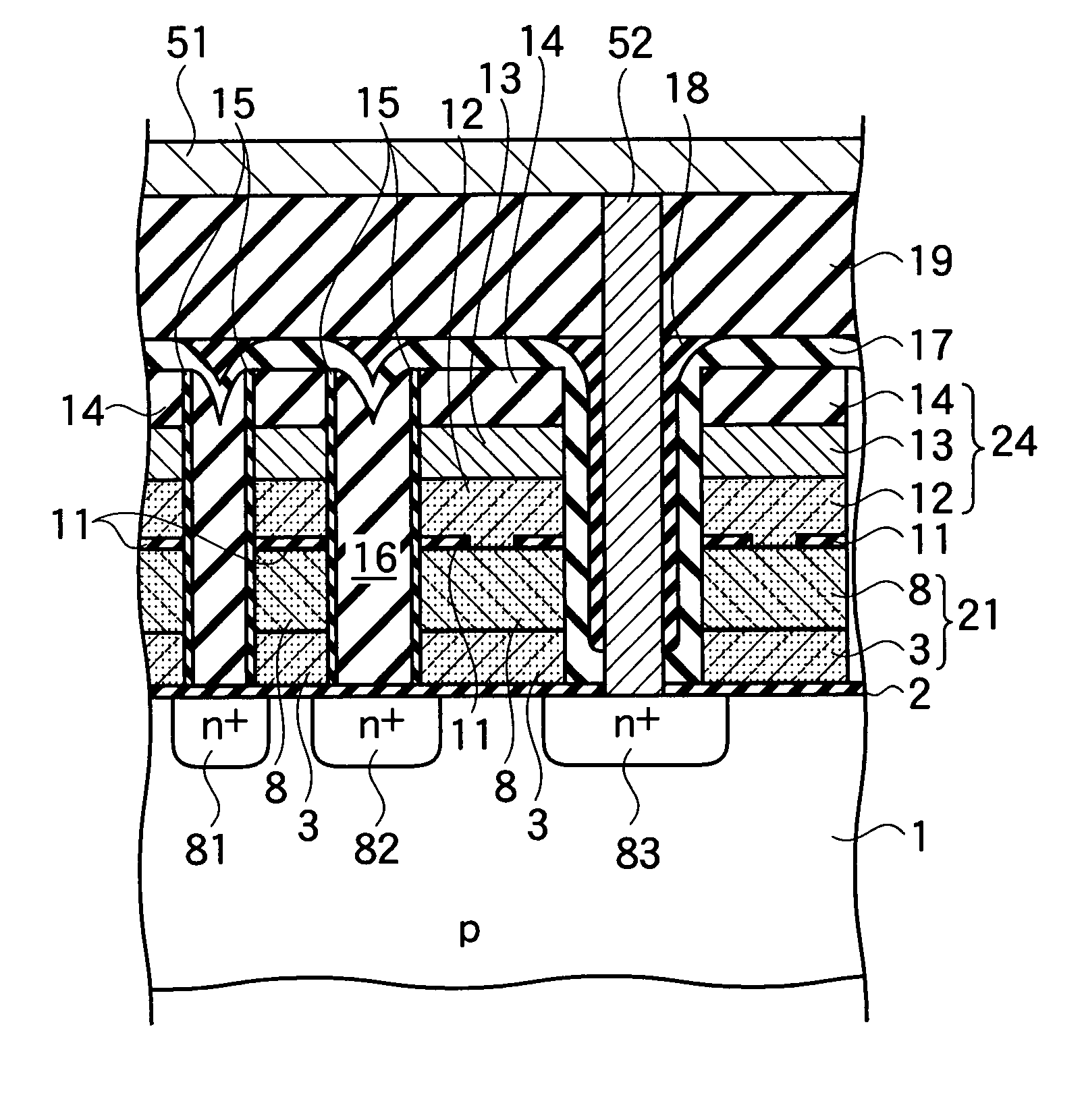Stacked gate semiconductor memory
a technology of semiconductor memory and stacked gate, which is applied in the field of semiconductor memory, can solve the problems of non-uniform distortion of the geometries and sizes of the respective memory cells, and the difficulty of achieving high-integration stacked gate memory cells with reduced power dissipation
- Summary
- Abstract
- Description
- Claims
- Application Information
AI Technical Summary
Problems solved by technology
Method used
Image
Examples
first embodiment
[0076]FIG. 4 is a block diagram illustrating a schematic circuitry of NAND flash memory as a semiconductor memory according to a first embodiment of the present invention. Peripheral circuits (91, 92, 93, and 94) such as a top page buffer 91, a bottom page buffer 92, a left row decoder / charge pump 93, and a right row decoder / charge pump 94 are arranged on the periphery of a memory cell matrix 90.
[0077]As shown in FIGS. 4 and 5, the memory cell matrix 90 embraces plural cell columns (NAND cell columns) extending along a column-direction, the cell columns are arranged along a row-direction in parallel. Each of the cell columns is implemented by plural memory cell transistors serially arranged along the column-direction. Each of the memory cell transistors has a charge accumulation layer whose electric charge accumulation level is configured to be controlled separately. The horizontal lines connected to all the memory cell transistors in corresponding rows are called “the word lines WL...
second embodiment
[0124]Similar to the semiconductor memory according to the first embodiment, a second embodiment of the present invention has a memory cell matrix, which embraces plural cell columns (NAND cell columns) extending along a column-direction, the cell columns are arranged along a row-direction in parallel. Plural memory cell transistors serially arranged along the column-direction implement each of the NAND cell columns. Each of the memory cell transistors is implemented by a stacked gate architecture, in which a charge accumulation layer is encompassed. Each of the electric charge accumulation levels in the respective charge accumulation layers, which are arranged in a matrix form, is controlled separately. FIG. 22 is a cross sectional view showing a corresponding part of the memory cell matrix 90 taken on line VB—VB in FIG. 5.
[0125]As shown in FIG. 22, the memory cell matrix of the semiconductor memory according to the second embodiment encompasses: device isolation films 7, which are...
third embodiment
[0156]As shown in FIG. 7B, in the erase operation of the semiconductor memory according to the first embodiment, when the erase gate voltage applied to the control gate electrode 24, which is determined so that a desired tunneling current can flow through the gate insulator 2, increases higher than the voltage in the case where there is no positive charge layer, since the effective tunneling distance established in the inter-electrode dielectric 11 becomes shorter, the amount of tunneling leakage current flowing through the inter-electrode dielectric 11 increases. A more preferable structure for suppressing such tunneling leakage current will be explained, referencing energy band diagrams shown in FIGS. 34A and 34B, in a semiconductor memory according to a third embodiment.
[0157]Similar to the structure shown in FIGS. 6A and 6B, in the semiconductor memory according to the third embodiment, each of the memory cell transistors is implemented by a stacked gate architecture, in which t...
PUM
 Login to View More
Login to View More Abstract
Description
Claims
Application Information
 Login to View More
Login to View More - R&D
- Intellectual Property
- Life Sciences
- Materials
- Tech Scout
- Unparalleled Data Quality
- Higher Quality Content
- 60% Fewer Hallucinations
Browse by: Latest US Patents, China's latest patents, Technical Efficacy Thesaurus, Application Domain, Technology Topic, Popular Technical Reports.
© 2025 PatSnap. All rights reserved.Legal|Privacy policy|Modern Slavery Act Transparency Statement|Sitemap|About US| Contact US: help@patsnap.com



